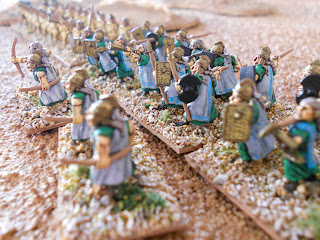Representations fall into two groups. The first group represents Warrior Gods (Boghazkoy Gate Sculpture; the “Running Gods” of Yazilikiya and a series of small statues, also from Boghazkoy). All date to the Imperial Period, and portray a warrior wearing a tunic and a kilt, a conical plumed helmet and carrying an axe. The second group comes from Egypt, from the representation of the battle of Qadeš that covers several walls of the Ramesseum.
Here are portrayed
warriors (spearmen and charioteers) wearing ankle-length robes,
carrying round or convex shields and either unarmoured, wearing
some sort of cloth over only one shoulder – probably of leather,
felt or similar protective material – or, in the case of some
charioteers, scale armour.
The first group has generally been considered, in wargames sources, to represent royal guardsmen. There is however no evidence of this. The representations, as the horns on the helmet clearly indicate, are of divinities. More to the point, during the Imperial Period, Hittite religion was thoroughly influenced by Hurrian beliefs, distilled into the country via Kizzuwatna. If the “Running Gods” and so forth mirror real-life warriors, those of Kizzuwatna are a more likely candidate.
The first group has generally been considered, in wargames sources, to represent royal guardsmen. There is however no evidence of this. The representations, as the horns on the helmet clearly indicate, are of divinities. More to the point, during the Imperial Period, Hittite religion was thoroughly influenced by Hurrian beliefs, distilled into the country via Kizzuwatna. If the “Running Gods” and so forth mirror real-life warriors, those of Kizzuwatna are a more likely candidate.
A now lost 9th century “Neo-Hittite” stone carving represents warriors exactly like these, except that they carry a large round shield, a spear or javelin, and have a hoplite-like helmet crest. The absence of horns indicates that they are human warriors, not Gods. The key issue here is that “neo-Hittite” is somewhat of a misnomer, born of early archaeological confusion. The “Neo-Hittites” scattered over south-east Anatolia spoke the language of that region from ancient times, that is, Luwian, a tongue related to, but not identical to, Hittite….the idiom of ancient Kizzuwatna. My conclusion is that the so-called representations of the “Royal Guard” are far more likely to have been modeled on Kizzuwatnan soldiers (if modeled on humans at all).
As for the second group,
although they may or may not accurately represent the Hittite warrior
of the Old and Middle Kingdom – some suggest the clothing
they wear on the Ramesseum is “tropical issue” –
there is not really any other option. So that is what I have gone
with !
The Hittites, whose military methods were quite sophisticated, made early use of chariots, probably adopting them from their pre-Mitanni Hurrian neighbours if etymology is anything to go by. When Hattušili I berates his commanders for failing to take Uršum, he claims they “stand on chariots of water”, which suggests the chariot was already the spearhead of the Hittite army.
The exact
fighting method of Hittite chariots is a source of controversy.
Once again, the Ramesseum is the only source; three-man chariots
with a central-set axle are displayed, the crew armed with spear
and shield, all of which fuels speculation of shock tactics.
It has been suggested, however, that the third
crewman is a chariot runner, or even a normal infantryman grabbing
a lift, and Hittite sources refer to chariot-based archers rather
than spearmen. So what Hittite chariots actually looked like is
anyone’s guess; I have gone for two-man affairs.
The charioteers were probably wholly or partly provided by the Royal Bodyguard, whose existence is amply attested, from earliest times, in Hittite texts. These chaps would surely have been decked out in the scale armour that is shown on the Ramesseum.
The charioteers were probably wholly or partly provided by the Royal Bodyguard, whose existence is amply attested, from earliest times, in Hittite texts. These chaps would surely have been decked out in the scale armour that is shown on the Ramesseum.
Spearmen and archers
The Ramesseum shows massed ranks of infantry carrying a short spear (6-8 ft), but this is more likely to be an attempt to indicate vast numbers than a true portrayal of Hittite fighting formation. In any case, a phalanx-type formation was ill adapted to the rugged Anatolian highlands were Hittite kings, Suppiluliuma included, fought the vast majority of their campaigns. Gladiator’s Hittites, who are using javelins rather than spears, seem to me to best fit the bill. I have also painted up some foot archers.
The Ramesseum shows massed ranks of infantry carrying a short spear (6-8 ft), but this is more likely to be an attempt to indicate vast numbers than a true portrayal of Hittite fighting formation. In any case, a phalanx-type formation was ill adapted to the rugged Anatolian highlands were Hittite kings, Suppiluliuma included, fought the vast majority of their campaigns. Gladiator’s Hittites, who are using javelins rather than spears, seem to me to best fit the bill. I have also painted up some foot archers.
Allies
Among the surviving corpus of Hittite texts are a large number of treaties, diplomatic practice which appears to date to the earliest days of the Hittite kingdom.
Among the surviving corpus of Hittite texts are a large number of treaties, diplomatic practice which appears to date to the earliest days of the Hittite kingdom.
Depending
on the status of the other party, mutual or unilateral military
aid is frequently mentioned. In the days of Tudhaliya I, for example,
when Kizzuwatna was still a semi-independent kingdom, it agreed
to provide 1,000 foot soldiers and 100 chariots for the Great King’s
foreign wars.
I have already mentioned the possible appearance of Kizzuwatnan auxiliaries, of whom I have painted up a unit.
The “Central
Anatolian” allies come straight out of WRGs Armies of the
Ancient Near East, but I have no idea of the source for them; no
doubt the Ramesseum.






Aucun commentaire:
Enregistrer un commentaire